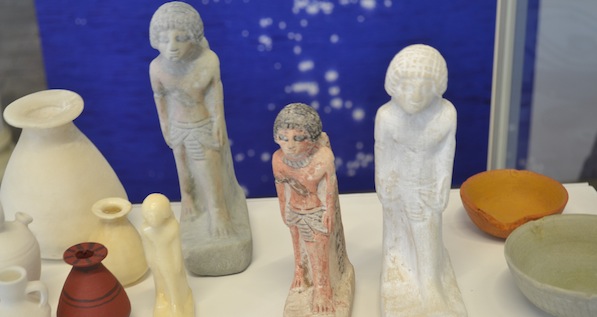
On a recent visit to Greece, my three-year-old son reached out and touched The Discus Thrower, a fifth-century B.C.E. statue first executed in bronze by Myron of Eleutherae. “Look, he’s throwing a plate,” my son said.
The statue he touched is a plaster replica, and so no one reprimanded him. (The Greek original is lost, and we know of its existence from Roman copies in stone.) But the experience reminded me how tactile children are, how they investigate and probe the world through their fingers and hands, touching, squeezing, stroking, molding. Indeed, that sense of touch is crucial to learning and development in children. Building with blocks, for example, has been shown to enhance math skills and spatial abilities.
The average museum exhibits little interest in allowing young visitors to handle ancient artifacts, however. So I was interested to read about the research of John Kaufman, a Ph.D. candidate at Lancaster University in England, who has developed a cheap method to reverse engineer replicas of fragile, 3,000-year-old Egyptian pottery held at the Kendal Museum in the northwest English county of Cumbria. The replicas can be handled by inquisitive children—and, for that matter, by adults.
“It is more and more the fashion in museums and galleries to allow the general public to engage with the artifacts,” Kaufman wrote to me via email. Some museums, he explained, even have “school boxes” that contain fossils or relics such as Roman coins. “But certain items, such as the Egyptian artifacts, are very rare and so cannot be allowed out from their glass cases.”
Kaufman used an inexpensive digital camera to photograph two of the Kendal Museum’s Egyptian treasures: a small, four-inch-high clay vase, and a seven-and-a-half-inch tall statuette of Sobekhotep, son of Nehesy, which dates to 1500 B.C.E. Its hieroglyphic inscription indicates that it served as his sister Kemet’s offering to the god Ptah-Sokar-Osiris. He placed each item on a revolving turntable, and as it rotated 360 degrees photographed the object up to 150 times every 10 to 15 degrees. In contrast, he says, other, more expensive methods employ up to 60 or 80 digital cameras “linked or tethered, positioned around the objects to fire simultaneously.”
With the aid of software called Agisoft PhotoScan Pro, Kaufman transformed this stream of images into one three-dimensional image of the original. The 3D image is converted into a computer file that can be read by 3D printing machines, which can reproduce the original model in materials ranging from sandstone to silver.
Kaufman’s method is so cheap and simple to operate—costing a fraction of the price of laser scanning technology typically used by universities—that it could easily be employed by museum workers with minimal training. The Kendal Museum, he adds, “recently had an open day, and several of my replicated models were available to the general public. Seeing the original in the glass-fronted cabinet, the visitors were intrigued and fascinated to be able to hold the copies.”

